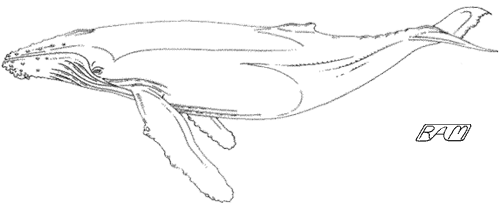Giants: Humpback Whale
(Megaptera novaeangliae)
Maximum Length = 52.5 feet (16 metres)
Maximum Weight = 38.5 tons (35 tonnes)*

The Humpback Whale is one of the best-known of baleen whales. It is easily recognized by its long pectoral flippers and lumpy dorsal fin. Because they are slow swimmers and breed in inshore waters, Humpbacks were among the first species to be decimated by commercial whalers. In the Northern Hemisphere, Humpbacks feed in rich arctic waters and breed in warm tropical seas, those of the North Atlantic calving and mating in the Caribbean, while those of the North Pacific do so near Hawaii. Southern Hemisphere Humpbacks feed in Antarctic waters and breed in warmer waters of South America, South Africa, New Zealand, South Australia, and certain South Pacific islands, such as Tonga and New Caledonia. Off Alaska, Humpback Whales employ a remarkable cooperative feeding technique, actually taking turns to use a precisely exhaled spiral of bubbles to corral small schooling fishes while the others rise in the center to feed on the concentrated prey. It was recently discovered that female calves of the Southern Hemisphere do not migrate to Tongan and New Caledonian waters until they are several years old, a strategy which allows them to conserve energy stores toward their first pregnancy. Humpback Whales are also famous for their eerie, haunting "songs" that are complexly structured and may last as long as 22 minutes before repeating. Songs are performed in a head-down orientation and sung only by the males — possibly to attract females, repel rivals, or both. These songs change continually and are sung by all the males of a given population. But each population has its own 'hit parade', so that Humpback Whales of Australia sing a completely different song from those of New England.
*1 ton = 2,000 pounds: 1 tonne = 1,000 kilograms
